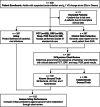A 29-mRNA host response test from blood accurately distinguishes bacterial and viral infections among emergency department patients
- PMID: 34142256
- PMCID: PMC8211458
- DOI: 10.1186/s40635-021-00394-8
A 29-mRNA host response test from blood accurately distinguishes bacterial and viral infections among emergency department patients
Abstract
Background: Whether or not to administer antibiotics is a common and challenging clinical decision in patients with suspected infections presenting to the emergency department (ED). We prospectively validate InSep, a 29-mRNA blood-based host response test for the prediction of bacterial and viral infections.
Methods: The PROMPT trial is a prospective, non-interventional, multi-center clinical study that enrolled 397 adult patients presenting to the ED with signs of acute infection and at least one vital sign change. The infection status was adjudicated using chart review (including a syndromic molecular respiratory panel, procalcitonin and C-reactive protein) by three infectious disease physicians blinded to InSep results. InSep (version BVN-2) was performed using PAXgene Blood RNA processed and quantified on NanoString nCounter SPRINT. InSep results (likelihood of bacterial and viral infection) were compared to the adjudicated infection status.
Results: Subject mean age was 64 years, comorbidities were significant for diabetes (17.1%), chronic obstructive pulmonary disease (13.6%), and severe neurological disease (6.8%); 16.9% of subjects were immunocompromised. Infections were adjudicated as bacterial (14.1%), viral (11.3%) and noninfected (0.25%): 74.1% of subjects were adjudicated as indeterminate. InSep distinguished bacterial vs. viral/noninfected patients and viral vs. bacterial/noninfected patients using consensus adjudication with AUROCs of 0.94 (95% CI 0.90-0.99) and 0.90 (95% CI 0.83-0.96), respectively. AUROCs for bacterial vs. viral/noninfected patients were 0.88 (95% CI 0.79-0.96) for PCT, 0.80 (95% CI 0.72-89) for CRP and 0.78 (95% CI 0.69-0.87) for white blood cell counts (of note, the latter biomarkers were provided as part of clinical adjudication). To enable clinical actionability, InSep incorporates score cutoffs to allocate patients into interpretation bands. The Very Likely (rule in) InSep bacterial band showed a specificity of 98% compared to 94% for the corresponding PCT band (> 0.5 µg/L); the Very Unlikely (rule-out) band showed a sensitivity of 95% for InSep compared to 86% for PCT. For the detection of viral infections, InSep demonstrated a specificity of 93% for the Very Likely band (rule in) and a sensitivity of 96% for the Very Unlikely band (rule out).
Conclusions: InSep demonstrated high accuracy for predicting the presence of both bacterial and viral infections in ED patients with suspected acute infections or suspected sepsis. When translated into a rapid, point-of-care test, InSep will provide ED physicians with actionable results supporting early informed treatment decisions to improve patient outcomes while upholding antimicrobial stewardship. Registration number at Clinicaltrials.gov NCT03295825.
Keywords: Acute infection; Diagnostics; Emergency department; Gene expression; Host response; InSep; Sepsis.
Conflict of interest statement
James W. Wacker, Sabrina M. Coyle, Henry K. Cheng, Oliver Liesenfeld, and Timothy E. Sweeney are employees of, and shareholders in Inflammatix. The other authors have no conflicts of interest to declare. E.J. Giamarellos-Bourboulis has received honoraria from Abbott CH, Angelini Italy, InflaRx GmbH, MSD Greece, XBiotech Inc., and B·R·A·H·M·S GmbH (Thermo Fisher Scientific); independent educational grants from AbbVie Inc, Abbott CH, Astellas Pharma Europe, AxisShield, bioMérieux Inc, Novartis, InflaRx GmbH, Swedish Orphan BioVitrum AB and XBiotech Inc; and funding from the FrameWork 7 program HemoSpec (granted to the National and Kapodistrian University of Athens), the Horizon2020 Marie-Curie Project European Sepsis Academy (granted to the National and Kapodistrian University of Athens), and the Horizon 2020 European Grant ImmunoSep (granted to the Hellenic Institute for the Study of Sepsis).
Figures




References
-
- Fleming-Dutra KE, Hersh AL, Shapiro DJ, Bartoces M, Enns EA, File TM, Jr, Finkelstein JA, Gerber JS, Hyun DY, Linder JA, Lynfield R, Margolis DJ, May LS, Merenstein D, Metlay JP, Newland JG, Piccirillo JF, Roberts RM, Sanchez GV, Suda KJ, Thomas A, Woo TM, Zetts RM, Hicks LA. Prevalence of inappropriate antibiotic prescriptions among us ambulatory care visits, 2010–2011. JAMA. 2016;315:1864–1873. doi: 10.1001/jama.2016.4151. - DOI - PubMed
-
- Barlam TF, Cosgrove SE, Abbo LM, MacDougall C, Schuetz AN, Septimus EJ, Srinivasan A, Dellit TH, Falck-Ytter YT, Fishman NO, Hamilton CW, Jenkins TC, Lipsett PA, Malani PN, May LS, Moran GJ, Neuhauser MM, Newland JG, Ohl CA, Samore MH, Seo SK, Trivedi KK. Implementing an antibiotic stewardship program: guidelines by the infectious diseases society of America and the society for healthcare epidemiology of America. Clin Infect Dis. 2016;62:e51–77. doi: 10.1093/cid/ciw118. - DOI - PMC - PubMed
-
- Metlay JP, Camargo CA, Jr, MacKenzie T, McCulloch C, Maselli J, Levin SK, Kersey A, Gonzales R, Investigators I. Cluster-randomized trial to improve antibiotic use for adults with acute respiratory infections treated in emergency departments. Ann Emerg Med. 2007;50:221–230. doi: 10.1016/j.annemergmed.2007.03.022. - DOI - PubMed
Associated data
LinkOut - more resources
Full Text Sources
Medical
Research Materials
Miscellaneous

